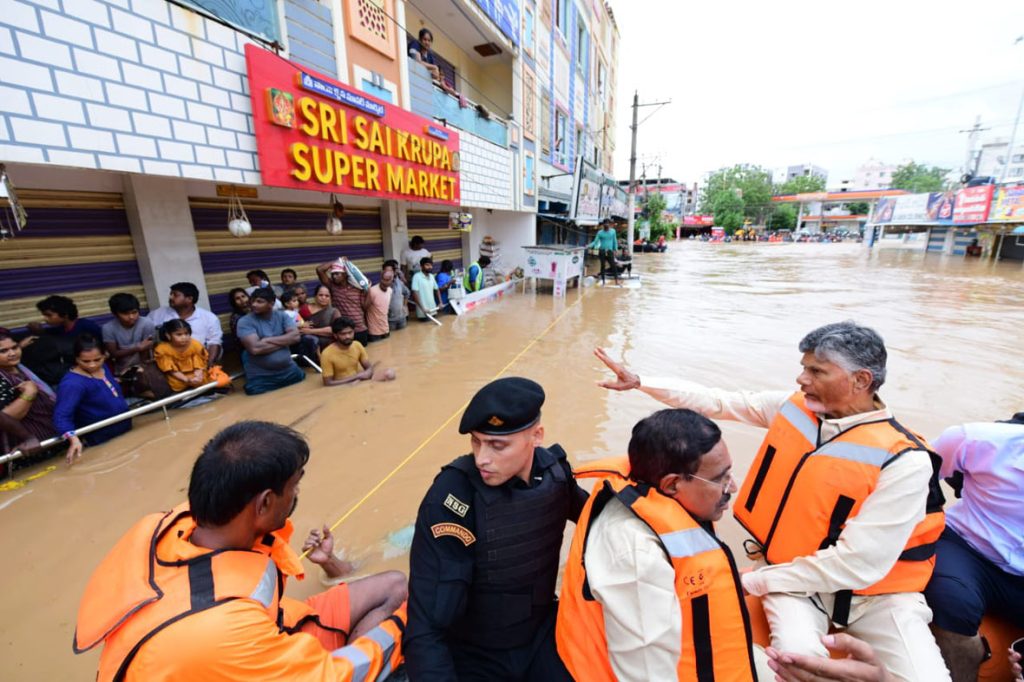
In an unprecedented display of nature’s fury, Andhra Pradesh and Telangana have been grappling with torrential rains and devastating floods, marking one of the most severe weather events in 2024.
The deluge, which commenced over the weekend, has left a trail of destruction, affecting millions and prompting immediate action from both state governments and the central leadership.
The wrath of rain
The rains, relentless in their intensity, have led to widespread flooding, with over 100 villages submerged across both states.
In Andhra Pradesh, particularly in regions around Vijayawada, life came to a standstill as water levels rose, necessitating the evacuation of approximately 17,000 individuals to safer grounds.
Meanwhile, Telangana is facing its own battle, with nine reported deaths due to rain-related incidents, highlighting the severity of the situation.
The state capital, Hyderabad, along with several other districts, experienced continuous downpours that led to significant disruptions, including the cancellation of 21 trains and the diversion of 12 others due to waterlogged tracks.
Government response and relief efforts
Chief Ministers N Chandrababu Naidu of Andhra Pradesh and A Revanth Reddy of Telangana have been leading the crisis management.
In Andhra Pradesh, CM Naidu’s administration focused on immediate evacuations, setting up relief camps, and putting up a robust disaster response mechanism.
Both states have seen the deployment of NDRF and SDRF teams, which have been instrumental in rescuing individuals from marooned areas, with over 600 people saved in Telangana alone.
CM Revanth Reddy of Telangana held emergency reviews and ensured that relief measures were promptly deployed.
Mr. Reddy communicated directly with his ministers and officials, emphasizing the need for swift action to mitigate the loss of life and property.
The state machinery was put on high alert, with special control rooms established to monitor the situation and coordinate rescue operations.
Prime Minister Modi’s Assurance
Prime Minister Narendra Modi, recognizing the gravity of the situation, personally reached out to both Chief Ministers.
In these conversations, PM Modi assured them of the Centre’s full support, promising all possible assistance to tackle the crisis.
The assurance was immediately followed by action, with the central government mobilizing resources to aid the flood-hit regions.
Modi’s engagement reflected a coordinated effort between the states and the Centre, which aimed to provide relief and rehabilitation as soon as possible.
Community and Volunteer efforts
Beyond government efforts, the spirit of community and volunteerism has shone brightly. Reports from social media and local sources highlight significant contributions from NGOs, local bodies, and individual volunteers.
These efforts included distributing food packets, setting up kitchen centers, and providing essential supplies like water, sanitary pads, and medical aid, showcasing a community’s resilience in adversity.
What lies ahead?
As the waters begin to recede, the focus shifts towards rehabilitation and rebuilding.
The governments of Andhra Pradesh and Telangana, with support from the Centre, are likely to initiate long-term measures to prevent such devastations in the future, including better flood management systems and infrastructure development.
This episode of natural calamity has tested the administrative mettle of these states and highlighted the importance of community solidarity and governmental preparedness.